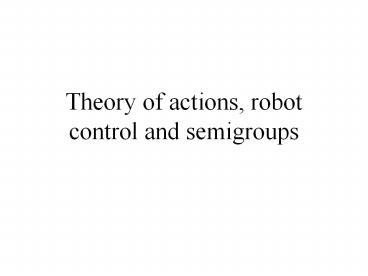Theory of actions, robot control and semigroups PowerPoint PPT Presentation
1 / 27
Title: Theory of actions, robot control and semigroups
1
Theory of actions, robot control and semigroups
2
(No Transcript)
3
(No Transcript)
4
Stanford
5
Vanderbilt
MIT
6
Theory of actions
- Aristotle. Nicomachean Ethics (Third Book).
- A.Mele, editor. The Philosophy of Action. Oxford
University Press, Oxford, 1997. - F.Brown, editor. Proceedings of the 1987 workshop
on The Frame Problem in AI. - M.Georgeff, editor. Journal of Logic and
Computation, Special issue on Action and
Processes, 1994. - Working notes of AAAI Spring Symposium, 1995.
7
- What is left over if I subtract the fact that my
arm goes up from the fact that I raise my arm? - Ludwig Wittgenstein,
- Philosophical Investigations 621.
8
- Following a common approach in reasoning about
actions, dynamic systems are modeled in terms of
state evolutions caused by actions. A state is
a complete description of a situation the system
can be in. Actions cause state transitions,
making the system evolve from the current state
to the next one.
9
- In principle we could represent the behavior of a
system (i.e. all its possible evolutions) as a
transition graph where each node represents a
state, and is labeled with the properties that
characterize the state each arc represents a
state transition, and is labeled by the action
that causes the transition.
10
Honda Humanoid Robot
Honda Corporation
30 degrees-of-freedom
As it is impossible to search such huge spaces
for what constitutes a good action, it is
necessary to either find more compact
state-action representations, or to focus
learning on those parts of the state-action space
that are actually relevant for the movement task
at hand. Schaal S. Is imitation learning the
route to humanoid robots? Trends in Cognitive
Sciences. 1999. 3233-242.
11
Nao Project AI-05
Aldebaran Robotics
25 degrees-of-freedom
12
(No Transcript)
13
DNA nanomechanical devices
14
Myosin arm
15
Kinesin legs
16
A Synthetic DNA Walker for Molecular Transport
- Jong-Shik Shin
- Niles A. Pierce
gt 200 degrees-of-freedom
17
- gt 1000000000000000000000
- degrees-of-freedom for some DNA devices
18
In deductive planning complete knowledge of the
behavior of the system is phrased in axioms of
some logic. Propositional Dynamic Logics.
Rosenschein 1981. De Giacomo Lenzerini
1995. Situation calculus. Reiter 1993.
19
In deductive planning one is typically interested
in answering the following question Is there
a sequence of actions that, starting from an
initial state leads to a state where a given
property (the goal) holds?EXPTIMEcomplete
(Kozen Tiuryn 1990)
20
Humanoid robot at the Dynamic Brain Project at
the ATR Labs in Japan
The apparently simple idea of imitation opened a
Pandoras box of important computational
questions in perceptual motor control. There are
no satisfying answers to questions of appropriate
perceptual representations for imitation, motor
representations, and the learning of these
representations.
21
Degrees-of-freedom A1, A2, , An States
of Ai ai,1, ai,2, , ai,pi
Actions of Ai bi,1, bi,2, ,
bi,qi S(R) lt ? Q gt ? F ? ? F F1
? ? Fn, Fi ai,j 1 j pi ?
?1 ? ? ?n, ?i bi,j 1 j qi
Q Q0 ? Q1 ? Q2 ? Q3 ? Q4
22
Q0 Q0,1 ? Q0,2 ? Q0,3 ? Q0,4 ?
Q0,5 Q0,1 ai,jas,t as,tai,j
1 i n, 1
s n, 1 j pi, 1 t ps , Q0,2
bi,jbs,t bs,tbi,j
1 i n, 1 s n, i ? s, 1 j
qi, 1 t qs , Q0,3 ai,sbj,t
bj,tai,s
1 i n, 1 j n, i ? j, 1 s pi, 1
t qj , Q0,4 ai,sai,t 0 1 i
n, 1 s pi, 1 t pi , Q0,5
bi,tai,s 0 1 i n, 1 s pi, 1 t
qi .
23
Q1 ? ai,sbi,j ai,t
1 i n, 1 s pi, 1 t
pi, 1 j qi . Q2 ? aai,sbi,j
aai,t 1 i n, 1 s
pi, 1 t pi, 1 j qi, a ? F .
24
Q3 ? ai1,s1bi1,j1ai2,s2bi2
,j2air,srbir,jr
ai1,t1ai2,t2 air,tr 1
i1 lt i2 lt lt ir n, 1 s1 pi1, 1
s2 pi2, , 1 sr pir, 1
t1 pi1, 1 t2 pi2, , 1 tr
pir, 1 j1 qi1, 1 j2
qi2, , 1 jr qir . Q4 ?
aai1,s1bi1,j1ai2,s2bi2,j2
air,srbir,jr aai1,t1ai2,t2
air,tr 1 i1 lt i2 lt lt ir
n, r lt n, 1 s1 pi1, 1 s2
pi2, , 1 sr pir, 1 t1
pi1, 1 t2 pi2, , 1 tr
pir, 1 j1 qi1, 1 j2 qi2,
, 1 jr qir, a ? ((F1 ? ? Fn ) \
(Fi1 ? ? Fir)) .
25
(No Transcript)
26
(No Transcript)
27
(No Transcript)

